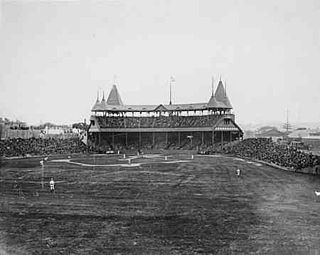
Exposition Park was the name given to three historic stadiums, located in what is today Pittsburgh, Pennsylvania. The fields were used mainly for professional baseball and American football from c. 1879 to c. 1915. The ballparks were initially located on the north side of the Allegheny River in Allegheny, Pennsylvania. The city was annexed into Pittsburgh in 1907, which became the city's North Side, located across from Pittsburgh's downtown area. Due to flooding from the nearby Allegheny River, the three stadiums' exact locations varied somewhat. The final version of the ballpark was between the eventual sites of Three Rivers Stadium and PNC Park.

South End Grounds refers to any one of three baseball parks on one site in Boston, Massachusetts. They were home to the franchise that eventually became known as the Boston Braves, first in the National Association and later in the National League, from 1871 through part of the 1914 season. That stretch of 43 1/2 seasons is still the longest tenure of the Braves club at any of their various ballparks and cities since 1914.
Haymakers' Grounds was a baseball grounds in Lansingburgh, New York, which is now part of Troy, New York. It was home to the Troy Haymakers of the National Association from 1871 to 1872 and home to the Troy Trojans of the National League from 1880 to 1881.

Avenue Grounds was a baseball field located in Cincinnati, USA. Also known as Brighton Park and Cincinnati Baseball Park, the ground was home to the Cincinnati Reds baseball club from April 25, 1876, to August 27, 1879. The ballpark featured a grandstand that could seat up to 3,000 fans. It was approximately 2 miles (3.2 km) north of the Union Grounds, where the original professional team from the area, the Cincinnati Red Stockings, played, and was approximately 4 miles (6.4 km) from the heart of the city, so horse-drawn streetcars and trains were a popular way to travel to the park. The ballpark had first opened in 1875, and would continue to be used for various types of amateur sports until at least the mid-1890s. The major league club of 1876–1879 played poorly, and actually dropped out of the league after the 1879 season. The club revived for 1880, and relocated to the Bank Street Grounds.
The Bank Street Grounds was a baseball park located in Cincinnati. The park was home to three major league baseball teams. The National League Cincinnati Stars club in 1880, the current Cincinnati Reds franchise from 1882 to 1883 and the Cincinnati Outlaw Reds of the Union Association in 1884. It succeeded the Avenue Grounds as the home site for professional ball in the Queen City.
Olympic Park is the name shared by two former baseball grounds located in Buffalo, New York, United States.

Ridgewood Park, also known as Wallace's Ridgewood Park or the Wallace Grounds, and frequently confused with Grauer's Ridgewood Park, was a baseball ground in Ridgewood, Queens, New York. Both Wallace's and Grauer's are shown in Belcher Hyde's Map of Newtown in 1915. The baseball field was part of a larger entertainment area bounded Wyckoff Avenue, Covert Street, Halsey Street, and Irving Avenue. The baseball field was southwest of the Long Island Rail Road's Montauk Branch tracks. Eldert Street, although depicted on the map as running through the baseball grounds, was not cut through southwest of the railroad tracks and the road remains interrupted there today. Originally the park was in Queens County, before its incorporation into New York City in 1899. This facilitated Sunday baseball playing, including the charging of admission, beyond the reach of Sabbath enforcers from the then-city of Brooklyn.

Starr Park is the name applied to several former sports stadiums in Syracuse, New York. The name referred to the Syracuse professional baseball teams, which were called the Stars beginning around 1870 and continuing in most seasons until the last Stars team was fielded in 1929.
Union Base-Ball Grounds was a baseball park located in Chicago. The park was "very visibly downtown", its small block bounded on the west by Michigan Avenue, on the north by Randolph Street, and on the east by railroad tracks and the lake shore, which was then much closer than it is today. The site is now part of Millennium Park.

The Boston Reds of 1884 were a professional baseball team that competed in the short-lived Union Association.
Recreation Park was the name applied to several former baseball parks in San Francisco, California in the late 19th century and early 20th century.
The Omaha Packers were a minor league baseball team based in Omaha, Nebraska. Between 1879 and 1935, Omaha minor league teams had a long tenure as members of the Western League and Western Association, winning five league championships. Omaha teams played under numerous other nicknames prior to the becoming the "Packers" in 1930.






